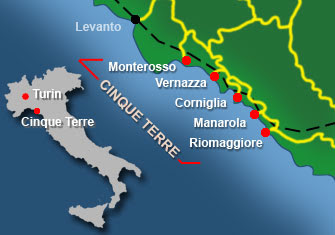
On Thursday 23 November 2006 we had an early breakfast, walked the short distance from the hotel to the Sestri Levante station and caught the train for Riomaggiore, or so we thought. Once again we were on the wrong train - this one whizzed southwards past Riomaggiore to La Spezia. There we finally found a train to take us north again as far as Riomaggiore. However, it was not all bad, because now we had the right tickets for the home journey at the end of the day and we knew exactly where we wanted to be.
The object of the day's excursion was to walk along as much of Italy's Cinque Terre (or Five Lands) as we could manage comfortably. The Cinque Terra covers 18 kilometers of sheer rocky coastline, terraced hills and vineyards sloping steeply down to the sea. Five little villages, Riomaggiore, Manarola, Corniglia, Vernazza and Monterosso (from south to north), are built into the rocks between the beach and the hills. The rare and threatened species of flora and fauna are protected throughout the Cinque Terre nature and marine park.
The villages are but a few minutes apart by train. There are almost no cars as the villages are not easily accessible by road, but the main railway between Rome and Paris runs along the coast, most often in tunnels.
Centuries-old footpaths and mule tracks wind about 200 to 400 m above the sea, leading through olive groves and vineyards, orchards and chestnut woods. You can hike between the villages, following the coastal paths. The hikes range from very easy to difficult.

At Riomaggiore we saw this amazing sea cave where the fishermen store their boats for the winter, hoisted onto racks above the sea.

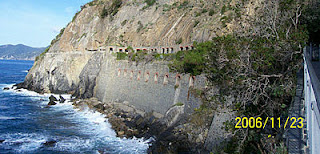
We started off our walk along the Via dell'Amore (Lovers' Path), cut out of the rocky cliff face, from Maggiore to Manarola.

Here we are walking along the last portion of the Lovers' Path, above the railway lines, towards Manarola.
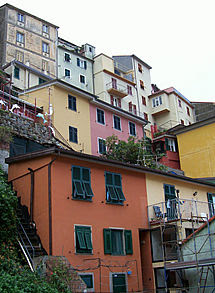

At Manarola there is only once way to go - up the hill. We were in awe of the houses painted in bright Mediterranean colours (shades of yellow, pink, white and terracotta) and literally stacked one on top of the other on the steep hillsides. Looking down along this street in Manarola it is clear that it is winter, since the boats are parked like cars and covered with tarpaulins, until the next fishing season.

From the church square one can choose to continue along the more level coastal path, or to climb up the winding path to a higher level with more spectacular views. We were keen on this higher path, but were told there would be a bus along shortly to take us up to Volastra. When we discovered it would be another hour before the bus arrived we decided to walk.

The route of the walking track is marked with red and white paint splashes on walls and trees. We soon found ourselves walking between a house on the left (the down-hill side) and its vegetable garden on the right. The owner's access to his garden is via this extremely narrow dry-stone staircase, with only a rope as hand-hold.
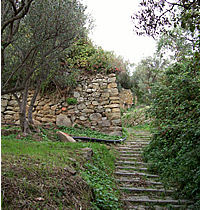
During the first part of the walk it was quite shady among the buildings close to Manarola, but as we progressed up the hill we started feeling the heat, even though it was cloudy most of the time. We were rather lucky with the weather that day, since it rained the day before and the day after!
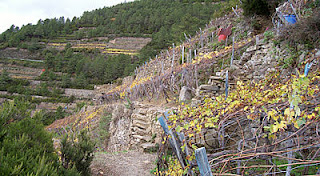
A unique characteristic of the area is the terraced vineyards supported by dry walling, a perfect example of landscape architecture created by man in inaccessible surroundings.

We found this low-growing wild pitcher plant along the edges of the path in semi-shade areas.

As we progressed up the hill and got closer to Volastra the path wound between the olive groves. It was interesting to see how olives are harvested. The farmer ties nets between the trees to catch the olives as they ripen and fall, and to keep the olives off the ground. Apparently the quality of the olives deteriorate quickly if they are left lying on the ground for longer than 24 hours.


Coming from New Zealand we associate kiwi fruit with New Zealand and Asia, so we were surprised to see this kiwi fruit crop next to the farmer's house. Another interesting sight was these mushrooms, carefully set out in the sun to dry.
This up-hill walk was quite tough, but well worth it. We could stop and enjoy the stunning scenery at our leisure all along the way. And so we arrived at Volastra. The walk continues...

No comments:
Post a Comment